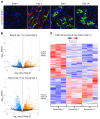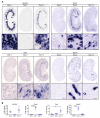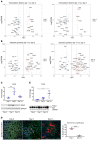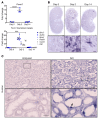FOXM1 drives proximal tubule proliferation during repair from acute ischemic kidney injury
- PMID: 31710314
- PMCID: PMC6877314
- DOI: 10.1172/JCI125519
FOXM1 drives proximal tubule proliferation during repair from acute ischemic kidney injury
Abstract
The proximal tubule has a remarkable capacity for repair after acute injury, but the cellular lineage and molecular mechanisms underlying this repair response are incompletely understood. Here, we developed a Kim1-GFPCreERt2 knockin mouse line (Kim1-GCE) in order to perform genetic lineage tracing of dedifferentiated cells while measuring the cellular transcriptome of proximal tubule during repair. Acutely injured genetically labeled clones coexpressed KIM1, VIMENTIN, SOX9, and KI67, indicating a dedifferentiated and proliferative state. Clonal analysis revealed clonal expansion of Kim1+ cells, indicating that acutely injured, dedifferentiated proximal tubule cells, rather than fixed tubular progenitor cells, account for repair. Translational profiling during injury and repair revealed signatures of both successful and unsuccessful maladaptive repair. The transcription factor Foxm1 was induced early in injury, was required for epithelial proliferation in vitro, and was dependent on epidermal growth factor receptor (EGFR) stimulation. In conclusion, dedifferentiated proximal tubule cells effect proximal tubule repair, and we reveal an EGFR/FOXM1-dependent signaling pathway that drives proliferative repair after injury.
Keywords: Adult stem cells; Nephrology; Stem cells.
Conflict of interest statement
Figures










Comment in
-
Contribution of dedifferentiated proximal tubule cells to repair in acute kidney injury.Nat Rev Nephrol. 2020 Feb;16(2):65. doi: 10.1038/s41581-019-0235-3. Nat Rev Nephrol. 2020. PMID: 31758084 No abstract available.
-
New insights into tubular cell recovery after ischemic acute kidney injury.Kidney Int. 2020 May;97(5):845-846. doi: 10.1016/j.kint.2020.01.014. Kidney Int. 2020. PMID: 32331592 No abstract available.
References
Publication types
MeSH terms
Substances
Grants and funding
LinkOut - more resources
Full Text Sources
Other Literature Sources
Molecular Biology Databases
Research Materials
Miscellaneous

